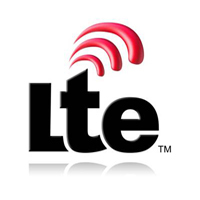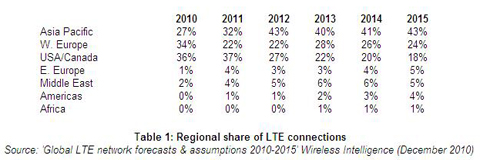  LTE networks will account for 4 percent of the world's mobile connections within five years, according to a major new report by Wireless Intelligence. The new study, Global LTE network forecasts and assumptions 2010-2015, predicts that global LTE connections will surpass the 1 million mark in the first half of 2011 and will reach 300 million by 2015 as the world's mobile operators ramp-up rollout of the next-generation network technology.
The study forecasts that Asia Pacific will be the world's largest LTE region by 2015, contributing almost half (43 percent) of global LTE connections by this point. China, the world's largest mobile market, is expected to account for around half of the Asia Pacific total. However, LTE network migration will initially be driven by operators in Western Europe and North America, which account for a combined 70 percent of global LTE connections in 2010. This is due to early LTE network rollouts by operators such as TeliaSonera (Europe) and Verizon Wireless (USA). Asia Pacific is expected to become the largest LTE market as migration gathers pace in major markets such as China, Japan, Indonesia and South Korea. The Americas and Africa are expected to be the two regions slowest to migrate to LTE, collectively accounting for just 5 percent of global LTE connections by 2015.
"The introduction of LTE networks reflects the move the telecoms industry is making towards delivering cloud-based and converged services, and an improved user experience," said Joss Gillet, Senior Analyst at Wireless Intelligence and author of the report. "Our latest forecasts show that LTE is being adopted by operators across the globe, but the pace of migration will be faster in countries where mobile broadband is on the political agenda and favourable regulatory developments are taking place – especially with regards to spectrum. However, creating a profitable ecosystem around the new networks will take time and it may take a few years for LTE services to live up to the hype."
The study is based on all known LTE deployments scheduled to take place over the next five years (excluding India). It predicts that 19 live LTE networks will be up-and-running across the globe by year-end 2010. These include major commercial LTE launches due later this month from market-leading operators such as NTT Docomo (Japan), Deutsche Telekom (Germany) and Etisalat (UAE). The world's first commercial LTE networks were launched a year ago by TeliaSonera in Sweden (Stockholm) and Norway (Oslo); TeliaSonera has since rolled-out LTE across its Nordic footprint, including in Finland and Denmark. Wireless Intelligence forecasts that global LTE connections will reach 350,000 by year-end 2010.
"Subscriber uptake of LTE is initially being driven by demand for data-centric mobile broadband services, typically accessed via USB dongles and embedded devices for which operators will charge a premium," said Gillet. "We predict that the introduction of voice over LTE (VoLTE) by around 2012 will mark the 'tipping point' for mass-market LTE handset volume shipments, which will accelerate LTE connections growth. However, premium price points and limited availability means that we will see low LTE handset penetration in the short term."
LTE migration will also be dependent on regulators allocating suitable frequency bands, the study says. It highlights three main spectrum scenarios for the deployment of LTE services; the release of IMT extension spectrum in the 2500-2600MHz bands, the release of 'digital dividend' spectrum in the 700-800MHz bands, and the re-farming of existing spectrum.

|